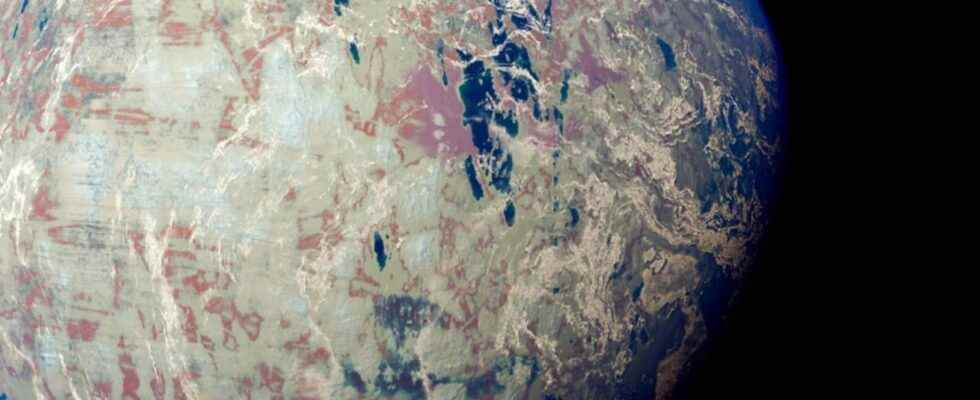The determination of reliable biosignatures that would at least allow us to think that an exoplanet very probably hosts forms of life similar to those known on Earth is not obvious. Take, for example, the case of the presence of large amounts ofoxygen in L’atmosphere of a rocky exoplanet the size of our Blue Planet. Should we conclude that it is populated by oxygen-producing photosynthetic organisms such as cyanobacteria that can be found on Earth and that build the stromatolites of Hamelin Pool in Australia ?
Unfortunately not, because we know that a significant photodissociation of molecules of water could produce such an atmosphere which would in fact correspond to an exoplanet where water liquid would have largely disappeared, as explained to Futura the astrophysicist Franck Selsis who encourages us to be very careful with the notion of biosignature. Exobiologists therefore know that it will probably take decades of observational studies and modeling of the atmospheres of many exoplanetsfor example thanks to the telescope James Webbbefore being able, perhaps, to have a moderate confidence in the relevance of certain biosignatures potentially yet to be discovered (it will probably be the combination of the detection of several molecules).
A series of general public courses on exobiology begins with this video. Are we alone in the universe ? You may have already asked yourself the question… We can find answers in films, literature or science fiction comics and our imagination is populated by extraterrestrial creatures! But what does science say about this? The AstrobioEducation site invites you to discover exobiology, an interdisciplinary science which aims to study the origin of life and its research elsewhere in the Universe. Through an educational journey divided into 12 stages, researchers from different disciplines will help you understand how science works to answer the fascinating questions of the origins of life and its research elsewhere than on Earth. © French Society of Exobiology
Lessons from the Arctic and Antarctic for exobiology
But nothing prevents exploring and proposing possible biosignatures now while keeping in mind that they are very open to criticism and that their detections in the near future should still be combined with healthy skepticism. It is in this critical state of mind that we must therefore take an article published in the journal Astrobiologyand that we owe to an international team comprising researchers from theInstituto Superior de Agronomia y Tecnico of Portugal, Laval University of Canada in Quebec and Cornell University in the United States.
We can still think that the biosignatures proposed in this article could be rapidly tested in the next two decades with Mars exploration missions and moons icy Jupiter and Saturn, Europe and Enceladus. Indeed, the researchers were inspired by the colors that colonies of microorganisms that can be studied in the subarctic conditions of Hudson Bay, Canada.
In fact, for decades we have been inspired by the study of life forms in the ice and rock environments of theArctic and of theAntarctic to define strategies to detect life on Mars. The article published today, and which would no doubt have attracted the attention of the great exobiologist Carl Sagantherefore only transposes this strategy in a certain way to icy exoplanets.
” Per Aspera Ad Astra – The Mars 160 Mission This seven-minute film was produced by the Mars Society to provide an up-close look at the organization’s two long-running Mars surface simulation programs – The Mars Desert Research Station (MDRS) in southern Utah and Flashline Mars Arctic Research Station (FMARS) in northern Canada. The film revolves around the recently completed Mars 160 twin mission, which took place initially at MDRS in 2016 and later at FMARS in 2017. For a fairly accurate French translation, click on the white rectangle at the bottom right. The English subtitles should then appear. Then click on the nut to the right of the rectangle, then on “Subtitles” and finally on “Translate automatically”. Choose “French”. © The Mars Society
A catalog of colors for 80 microorganisms
” On Earth, the vibrant biological colors ofArctic represent life signatures in small frozen niches », Explains the main author of the article published in AstrobiologyLígia F. Coelho, doctoral student who cultivated and studied microorganisms in subarctic conditions of this biota at the Institute Carl Sagan from Cornell (CSI).
The researcher also adds in a press release from Cornell University that: ” The colors of organisms could dominate the entire surface of icy worlds. Frozen exoplanets are not lost causes. With future telescopes, you might find the telltale signs of germs – if you know what to look for. »
With her colleagues, she therefore created a catalog of colorful signatures produced by a sampling of 80 microorganisms in ice and water in Kuujjuarapik, Quebec, but also at the mouth of the Great Whale River.
” Having the right tools to detect life forms on icy worlds is fundamental “, explains Zita Martins Martins, director of the laboratory of astrobiology of the Instituto Superior de Agronomia and Técnico who came up with the idea for this research with Lisa Kaltenegger, director of the CSI, who specifies that this ” study shows that biosignatures are more intense in drier environments, suggesting that places drier than Earth and containing microbial lifeforms could represent good targets for future space missions “.
Measurements to find out how these microbes would present to our telescopes were made in the lab of William Philpot, a professor in the School of Civil and Environmental Engineering at Cornell.
Another video taken from a series of general public courses on exobiology. The habitable zone of a star! What is behind this notion? What approximations, useful simplifications to guide our search for life elsewhere? Some explanations by the astrophysicist Franck Selsis in nine minutes! © French Society of Exobiology
Interested in what you just read?
